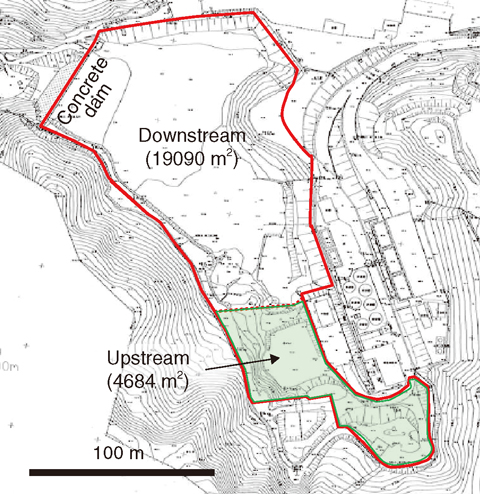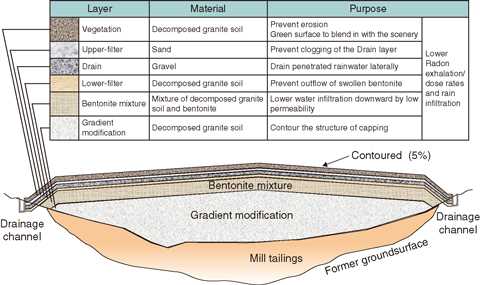
Fig.8-6 Yotsugi Mill Tailings Pond

Fig.8-7 Structure and material of the capping constructed “Upstream”
Ningyo-toge Environmental Engineering Center has been managing the Ningyo-toge Uranium Mine, now out of service for mining, in accordance with the Mine Safety Law. In parallel, the center has been conducting remediation activities to ensure the radiation protection from the exposure pathways to humans in the future and to prevent the occurrence of mining pollution.
Remediation has been planned not only to ensure safety required by the Mine Safety Law but to make it most appropriate technologically and economically. Among mine-related facilities subject to remediation, the highest priority has been placed on the Yotsugi Mill Tailings Pond, which is located upstream of the Yoshii-gawa River, one of the largest rivers in the Okayama Prefecture.
As part of the Pond, a concrete dam was directly constructed on geologically stable basement rock. Behind the dam, mill tailings generated through mining activities have been deposited. Moreover, mine water generated from former mine-mouths has been temporally impounded so that the Pond can be used as a buffer reservoir before being transferred to the Water Treatment Facility.
For the remediation of the Pond, a multi-layered capping was constructed “Upstream” between FY 2011 and FY 2012, wherein mill tailings were dominated by sand-grained material and not submerged. Its purpose was to reduce rainwater penetration to lower the burden of water treatment and to reduce radon exhalation and dose rates below 1 mSv/year without background (Fig.8-6).
Only natural materials have been used for the capping for long-term stability after remediation. As for the structure, a multi-layered capping was adopted with each layer having a separate purpose (Fig.8-7). Among the layers, the Bentonite mixture layer is mainly composed of bentonite, which is a kind of clay mineral that has a swelling property when soaked in water. It is expected that the layer should lower the degree of rainwater penetration from its surface downward and exhalation of radon gas generated from the mill tailings upward.
Above the Bentonite mixture layer, a “Drain layer” is set using gravel to drain penetrated rainwater laterally into a newly constructed drainage channel around the Pond. In addition, the structure of whole capping was composed with a convex shape with a north-south ridge to reduce the water amount that flows into the mill tailings to minimize the burden on the Water Treatment Facility.
At present, monitoring is being continued to verify the effectiveness of the capping in terms of several items, including settlement amount, drainage water amount, concentration rate of elements in the water, and dose rate. The monitoring will be continued to accumulate data for the abovementioned items, and the data is to be used for future remediation of the “Downstream” area, with revision of its specifications if necessary.